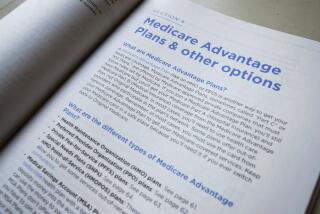Gearing up for a discount drug card
- Share via
Seniors may need to have a calculator and a crystal ball handy when they sign up for Medicare’s new drug-discount-card program.
Dozens of cards will be available for the program that goes into effect in June. Because different cards will cover different drugs, with varying discounts, seniors will have no assurances of how much money they are actually going to save by year’s end. Choosing a card in advance will be confusing and involve some guesswork, consumer advocates say.
The government’s drug-discount-card program is the first step in an overhaul of the Medicare drug benefit voted into law last year. Nearly all of the 41 million people in the Medicare program (for people age 65 and older and some disabled persons) are eligible to use the cards when the program goes into effect in June.
Consumer advocates caution that the discount-card program is unlikely to produce significant savings for most Medicare recipients.
“There is a lot about the plan that could be quite confusing for seniors, starting with the fact that a government-endorsed drug-discount card is not the same as the Medicare drug benefit,” says Tricia Neuman, a vice president with the Kaiser Family Foundation, a nonprofit group focusing on healthcare. “They have been hearing about the drug benefit for years. They may think this is their new Medicare benefit card when it is really a drug discount card.”
The cards work like this: Various sponsors -- including health insurers, pharmacies and firms that manage pharmacy benefit programs for employers -- apply to the government to sell the cards directly to consumers for an annual fee of $30 or less. Sponsors can begin advertising their cards this month and sign-ups begin in May. More than 70 sponsors have been approved and are listed on the Medicare website, www.medicare.gov.
Medicare recipients can sign up for one card only. People who belong to a Medicare managed-care plan or HMO must choose that plan’s members-only discount card if one is offered. Medicare recipients not bound by managed-care plans will be able to choose from dozens of cards. Some of the California insurance companies sponsoring cards are the Kaiser Foundation Health Plan (not affiliated with the Kaiser Family Foundation), Health Net and PacifiCare.
Seniors who want to make the savviest financial decision had better grab their calculators. It’s unlikely one card will cover every drug a person takes, and the size of the discounts will vary from card to card. In general, the federal government predicts that cardholders can expect to save 10% to 25% on particular drugs.
“In order to choose a plan best for them, they will need to stack their medications in front of them, focus on the ones that are the most expensive and find a card that gives them the greatest savings for those drugs,” Neuman says.
*
Acceptance not universal
Consumers should also check to see which pharmacies will accept the card they select. Not all pharmacies will accept all cards, and some discount cards will operate only through mail-order pharmacies.
Except in rare instances, consumers will not be able to switch cards until the end of the year. However, card sponsors will be free to change the discounts throughout the year and even add or drop particular drugs.
Moreover, the cards will not control actual prices, only discounts, says Jamie Court, president of the Foundation for Taxpayer & Consumer Rights, a nonprofit consumer advocacy group.
“The card states what discount you’ll get, but it doesn’t talk about the base cost of the drug,” he says. The discount cards do nothing to address the rising cost of prescription drugs, says Court.
According to Families USA, a consumer healthcare advocacy group, prices for the top 50 drugs used most often by seniors increased nearly 3.5 times faster, on average, than overall consumer inflation between January 2002 and January 2003.
Card sponsors will be required to post their price lists on the Medicare website so that consumers can comparison shop. Medicare officials say they will monitor the lists for bait-and-switch practices.
It’s normal business practice for drug prices to fluctuate throughout the year, says John Rother, policy director for AARP. But, he says, “the card sponsors will have to be very careful with this. They could damage their reputation if they are cavalier” about price fluctuations.
According to Rother, consumers can probably expect to find the biggest discounts on generic drugs, while the higher-cost brand-name drugs will be discounted slightly or not at all. In some cases, paying the full price on a generic drug may be cheaper than using a discount card to buy a brand-name drug.
In a statement released last month, Medicare officials said they believed that competition between the card sponsors would help drive down prices.
Some card sponsors say that enrolling high numbers of consumers in their programs will allow them to negotiate steeper discounts with drug suppliers, Rother says.
“What card sponsors are telling us is if they can get a lot of enrollment, they will be able to leverage bigger discounts,” he says. “But this is all speculative. Until we see the discounts, we just won’t know.”
Seniors who have Medigap policies or some other drug coverage can also select a discount card, although it’s unclear how much they will benefit from the card. Medicare recipients who have drug-discount cards that are offered by some pharmaceutical companies can continue to use those cards. However, only one discount card can be used per drug purchase.
Deciding which card to use at the drugstore counter may be difficult.
“A likely scenario is seniors will take their cards with them to the pharmacy and pull out the cards and ask the pharmacist which card to use when filling their prescription,” says Neuman.
*
More benefits for the poor
Although some consumer advocates are critical of aspects of the discount-card program, nearly everyone agrees that the poorest Medicare recipients with no other drug coverage will benefit the most. People with incomes of less than $12,569 per year (or married couples with incomes of $16,862 or less) qualify for a $600 credit on their cards.
“People who qualify for this credit should take full advantage of this. It’s a big deal,” says Rother.
“For everybody else, the thing to do is have modest expectations. It’s possible the card will generate some additional savings. But it’s hardly going to be the answer if you’re having trouble affording your medications.”
The key changes under the Medicare Prescription Drug Improvement and Modernization Act -- involving premiums and co-pays -- will go into effect in 2006.
The drug-discount-card program, however, was designed to provide some immediate savings to seniors.


